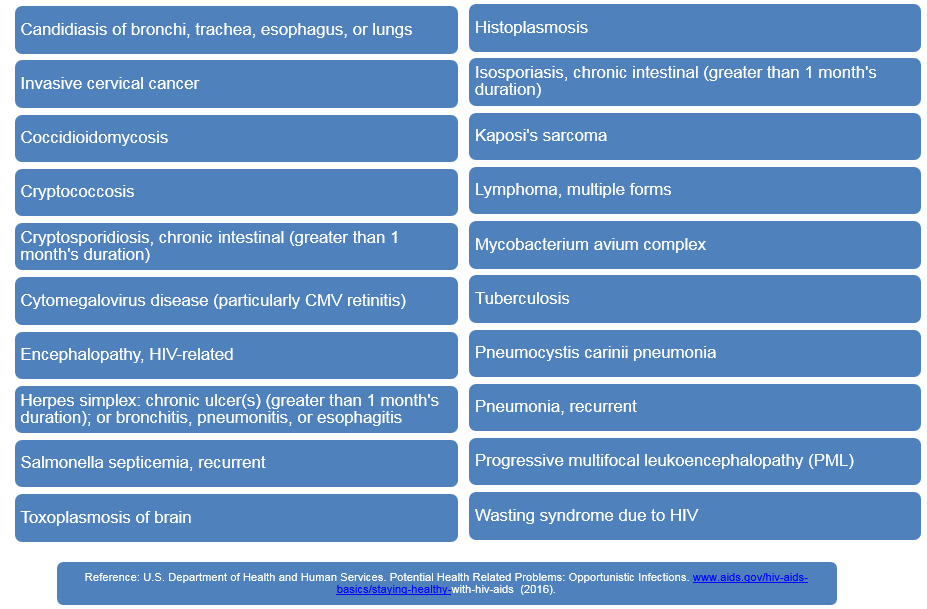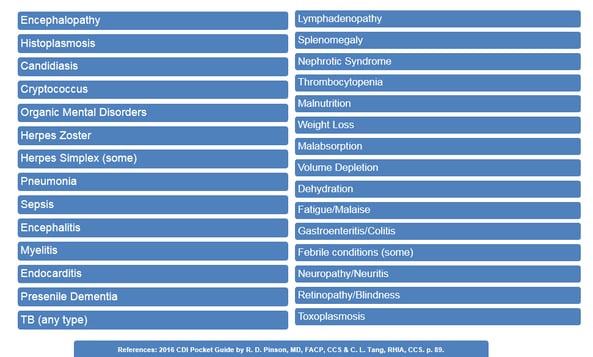Spring has finally arrived across most of the country. The landscape is taking on the colors of blooming flowers and trees. This time of year signals new opportunities so let’s revisit one of the diagnoses that can be confusing to coders - HIV and AIDS. We will endeavor to better understand the disease process and requirements for documentation. In turn, as coders, we will be better prepared to analyze record documentation, assign accurate code and identify when a query is needed.
Human Immunodeficiency Virus (HIV), is a retrovirus that destroys the immune system, disabling the body’s ability to fight infections causing some lymphomas, other malignancies, and opportunistic infections to grow. The Official Coding Guidelines that we followed for coding HIV/ Acquired Immune Deficiency Syndrome (AIDS) in ICD-9-CM have not changed for ICD-10-CM. The only difference is that the codes have changed:
- B20 – AIDS (previously 042)
- Z21 – asymptomatic HIV status, HIV + (previously V08)
Regardless of whether a patient is newly diagnosed or has had previous admissions/encounters for HIV conditions, is irrelevant to the sequencing decisions.
- Code only confirmed cases of HIV infection/illness – Inpatient & Outpatient
- Chart documentation with qualified diagnoses such as “possible”, “probably”, “rule out”, “suspected” or “suspicion of” are never reported as AIDS (B20) – Inpatient or Outpatient
This is an exception to the rule on the Inpatient side!
- In this context, “confirmation” does not require documentation of positive serology or culture for HIV; the provider’s diagnostic statement that the patient is HIV positive, or has an HIM-related illness is sufficient.
HIV Positive: Code Z21
Used when the patient has never been diagnosed with AIDS or an AIDS-defining condition. Also called “asymptomatic HIV” in ICD-10-CM.
- Documentation coded as Z21 (not AIDS) – HIV positive, HIV +, HIV Infection, asymptomatic HIV, known HIV, HIV test positive. Do not use if the term “AIDS” is documented for the patient or the patient has any HIM-related illness or has a history of any HIV-related conditions.
- A diagnosis of HIV + (Z21) is not the same as a diagnosis of HIV infection, symptomatic HIV/AIDS, and AIDS (B20)
Diagnostic Criteria
For adults, adolescents, and children >18 months of age, the CDC defines AIDS as an HIV-positive patient with any one of the following:
- Current or prior diagnosis of an AIDS-defining condition
OR
- Current or prior CD4+ T-Lymphocyte count <200
- The CD4 count is a clinical indicator, however, the provider MUST document AIDS, HIV-related illness, etc., or a query is necessary.
Coding for HIV
For inpatient coding, the physician must state the diagnosis, and if not clearly documented, there is an opportunity to query for clarification. For outpatient coding, it is often challenging for coders to determine if the patient is just HIV + (Z21) or if the patient has ever had an HIV-related illness (B20). As of now, most outpatient coders do not have the capability to query for OP coding. If the coder is unable to determine which the patient has based on the documentation provided, we should default to asymptomatic, rather than assigning the patient a diagnosis of AIDS.
Opportunistic Infections (OIs)
Healthy immune systems can be exposed to certain viruses, bacteria, or parasites and have no reaction to them. However, people living with HIV/AIDS may have serious health threats from what are known as “opportunistic infections (OIs)”. These infections attack the weakened immune system and can be life-threatening. OIs are signs of a declining immune system. Most life-threatening OIs occur when the CD4 count falls below 200 cells/mm3. The CDC developed a list of more than 20 OIs that are considered AIDS-defining conditions. Patients having laboratory-confirmed HIV infections and one or more of these OIs, will be diagnosed with AIDS regardless of the CD4 count.
 Acquired Immunodeficiency Syndrome (AIDS)
Acquired Immunodeficiency Syndrome (AIDS)
AIDS is the final stage of human immunodeficiency virus (HIV) infection, stage 4 by the World Health Organization (WHO) criteria (2007) and stage 3 by Centers for Disease Control and Prevention (CDC) (2008) criteria or clinical categories B or C (CDC). AIDS code (B20) applies if AIDS has ever been previously diagnosed. B20 must always be coded on every single subsequent encounter and never again code Z21 once AIDS is assigned.
- Documentation coded as B20 –AIDS: HIC illness, HIV disease, ARC (AIDS-related complex), HIV symptomatic (any current AIDS-defining condition), HIV currently being treated for an HIV-related illness or is described as having any condition resulting from HIV + status, Acquired immune deficiency syndrome.
- Once a patient has any HIV-related illness (OI0, every subsequent encounter should be coded as AIDS (B20)
- Asymptomatic HIV (Z21) and inclusive HIV R75) are never reported once a patient has a confirmed diagnosis of AIDS.
Major AIDS-Related Conditions
Therapeutic Treatment
- Antiretroviral treatment: (HAART) combination of drugs recommended
- Pre-Exposure Prophylaxis (PrEP)
- Post-Exposure Prophylaxis treatment for occupational exposure (PEP)
-Zidovudine (Retrovir, ZDZ,AZT) and Lamivudine (Epivir, 3TC) = Combivir
-Lamivudine (Epivir, 3TC) and Stavudine (Zerit, d4T)
-Didanosine (Videx, Videx EC, ddl) and Stavudine (Zerit,d4T)
- Fulyzag for treatment of antiretroviral treatment-induced diarrhea
A lot of information is included that I trust will clarify the assignment of HIV and AIDS as well as opportunities for the query. Take time to enjoy the Spring!
REFERENCES
- Reference: Optum: Guide to Clinical Validation, Documentation and Coding (2014) p.34
- References: 2016 CDI Pocket Guide by R. D. Pinson, MD, FACP, CCS & C. L. Tang, RHIA, CCS. p.87, 88.
- Reference: Optum: Guide to Clinical Validation, Documentation and Coding (2014) p.30.
- Reference: U.S. Department of Health and Human Services. Potential Health Related Problems: Opportunistic Infections. www.aids.gov/hiv-aids-basics/staying-healthy-with-hiv-aids (2016).
- References: ICD-10-CM Official Guidelines and Reporting 2017 1.a.1.2
About the Author
Marie Thomas holds a Masters in Healthcare Administration from Pfeiffer University, Charlotte, NC, and a Bachelor of Science in Healthcare Administration from Pfeiffer University. Marie has furthered her career education by becoming an AHIMA-Approved ICD-10-CM/PCS Trainer and Ambassador as well as earning the RHIT, CCS, CCDS, and CPC-H credentials. For more information please comment below.



